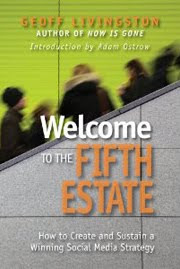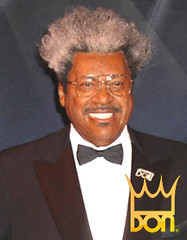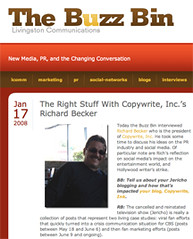The best thing about Marketing In The Round by Gini Dietrich and Geoff Livingston is it offers up a litany of questions, ideas, and thumbnail case studies. The worst thing about it is that it doesn't always know what kind of book it wants to be or for whom it is intended.
So perhaps that's the best place to begin. Who could benefit from Marketing In The Round?
Small business owners. People who need a crash course in marketing, one with an emphasis on the changes taking place in the market today. While many small business owners will find the details to be overwhelming, the book provides enough insights and ideas to help them ask the right questions.
Middle management marketers. This isn't necessarily the stuff of senior management, but it does provide enough material for middle management to check their work. It could be useful in comparing some of the concepts and constructs that Dietrich and Livingston lay out and making adjustments.
Multi-discipline communicators. Given that the central theme is really about convergence, Marketing In The Round provides a Rosetta stone approach for future advertising, marketing, public relations, and social media professionals. Along with them, it can serve specialists who are finding more and more of their work is falling outside their specialty, whether they working in any of those fields I mentioned.
Those are the people who could most benefit, along with those who find themselves communication curious and don't mind a book that attempts to bridge the gap between anecdotal and textbook. It doesn't quite do the job at finding that elusive middle, but it's a good effort to move conversations about marketing, public relations, and social media into a more mature, professional, and educational discussion.
The three strongest aspects of the book revolve around big concepts.
As the title suggests, this book is about forming a more integrated approach to marketing. The solution is feasible in that the authors suggest finding someone to champion the construct by drawing in one person from various communication departments to make it work.
Anyone who has worked on campaigns involving a partnership among several specialized firms knows how it will work (even if it sometimes produces mixed results depending the players). It's the right way, even if there isn't enough space dedicated to the plan pitch for bigger organizations.
The other construct introduced in the book is a marketing model based partly on The Book Of The Five Rings by Miyamoto Musashi. In this case, the analogy applies the five primary approaches of strategic engagement to marketing, allowing for top-down, direct, groundswell, and two flanks.
 While it would be easy to quibble with the idea that advertising is a flank, the analogy isn't far off in providing a means to help various specialists to stop thinking about communication from their specialized perspectives. The goal here is to get everyone to the same table.
While it would be easy to quibble with the idea that advertising is a flank, the analogy isn't far off in providing a means to help various specialists to stop thinking about communication from their specialized perspectives. The goal here is to get everyone to the same table.
There is considerable strength in that Dietrich brings public relations experience to the table while Livingston has a background in marketing. There is some give and take here, rather than an attempt to pit one expertise over another. Also, they both have ample social media experience.
Because of this, they also decided to include some tactile tools into the mix: checklists, questionnaires, forms, and exercises to help move the book from a concept into something concrete. It will be appreciated, especially because the publisher has made them downloadable (negating the need to recreate the lists or scan the pages).
The weakest aspects of the book revolve around the superficial.
The book is well-written from a technical aspect, but it's not reader friendly. The content pummels, making it impossible to read as a single serving. It's best read no more than one chapter at a sitting with time built in to reflect on how it applies.
 Likewise, if you are hoping to bring the ideas into an organization or a classroom, you have to read it with a notebook nearby. While there is a reason why Marketing In The Round is organized like it is, you are precluded from starting any exercises early. For example, if you start writing out "smarter goals" at the end of chapter one, you will certainly rip them up by the time you reach chapter four.
Likewise, if you are hoping to bring the ideas into an organization or a classroom, you have to read it with a notebook nearby. While there is a reason why Marketing In The Round is organized like it is, you are precluded from starting any exercises early. For example, if you start writing out "smarter goals" at the end of chapter one, you will certainly rip them up by the time you reach chapter four.
This isn't the only way Marketing In The Round will make you work for it. The book does a great job introducing various thumbnail case studies that are always useful. However, it will require savvy communicators to search for additional resources for anyone not familiar with specific cases.
It's important, because you might draw different conclusions than the ones the authors have laid out. Sometimes they are needed and absent; other times they just feel forced. The Netflix case study is one example of the latter. It felt like affirmation mining — where the author wants to quickly prove a point and plugs in a case study as it fit, but neglecting all the blemishes and bruises that some with it.
All in all, those are relatively minor distractions. The only areas where I thought Dietrich and Livingston fell slightly short was in competitive analysis and measurement. While they succeed in delivering a solution, there just isn't enough content on these subjects. Specifically, there is a difference between knowing your competitors and providing a viable contrast, and benchmarking is always a good idea but it's only the tip of the measurement iceberg.
The net sum of all things related to Marketing In The Round.
The kinds of people who I think would most benefit aside, Marketing In The Round is an excellent mining book, meaning that there is more here to mine than can be included within the confines of a single review. There is considerable content that can be extracted, adapted, and deployed for the classroom or an organization.
All in all, it makes you appreciate that Dietrich and Livingston wrote a textbook that could have benefited from the space that writing a Marcom textbook would have provided. This in itself is a refreshing change from the anecdotal waste that pretends to be work in the field — books that are best described as a big "business card" or professional "memoir." Instead, the authors of Marketing In The Round actually want to teach you something. You're likely to learn something too.
I received a copy of the book Marketing In The Round for the purposes of review. If you cannot tell, neither receiving a copy nor having prior contact with the authors had any influence. In fact, I am predisposed to review marketing and public relations books exceptionally hard, which is why most people are too afraid to send me marketing or business books for review. You might also like to know that prior to receiving a copy, I had already planned to write an unsolicited review of this book.
So perhaps that's the best place to begin. Who could benefit from Marketing In The Round?
Small business owners. People who need a crash course in marketing, one with an emphasis on the changes taking place in the market today. While many small business owners will find the details to be overwhelming, the book provides enough insights and ideas to help them ask the right questions.
Middle management marketers. This isn't necessarily the stuff of senior management, but it does provide enough material for middle management to check their work. It could be useful in comparing some of the concepts and constructs that Dietrich and Livingston lay out and making adjustments.
Multi-discipline communicators. Given that the central theme is really about convergence, Marketing In The Round provides a Rosetta stone approach for future advertising, marketing, public relations, and social media professionals. Along with them, it can serve specialists who are finding more and more of their work is falling outside their specialty, whether they working in any of those fields I mentioned.
Those are the people who could most benefit, along with those who find themselves communication curious and don't mind a book that attempts to bridge the gap between anecdotal and textbook. It doesn't quite do the job at finding that elusive middle, but it's a good effort to move conversations about marketing, public relations, and social media into a more mature, professional, and educational discussion.
The three strongest aspects of the book revolve around big concepts.
As the title suggests, this book is about forming a more integrated approach to marketing. The solution is feasible in that the authors suggest finding someone to champion the construct by drawing in one person from various communication departments to make it work.
Anyone who has worked on campaigns involving a partnership among several specialized firms knows how it will work (even if it sometimes produces mixed results depending the players). It's the right way, even if there isn't enough space dedicated to the plan pitch for bigger organizations.
The other construct introduced in the book is a marketing model based partly on The Book Of The Five Rings by Miyamoto Musashi. In this case, the analogy applies the five primary approaches of strategic engagement to marketing, allowing for top-down, direct, groundswell, and two flanks.
 While it would be easy to quibble with the idea that advertising is a flank, the analogy isn't far off in providing a means to help various specialists to stop thinking about communication from their specialized perspectives. The goal here is to get everyone to the same table.
While it would be easy to quibble with the idea that advertising is a flank, the analogy isn't far off in providing a means to help various specialists to stop thinking about communication from their specialized perspectives. The goal here is to get everyone to the same table.There is considerable strength in that Dietrich brings public relations experience to the table while Livingston has a background in marketing. There is some give and take here, rather than an attempt to pit one expertise over another. Also, they both have ample social media experience.
Because of this, they also decided to include some tactile tools into the mix: checklists, questionnaires, forms, and exercises to help move the book from a concept into something concrete. It will be appreciated, especially because the publisher has made them downloadable (negating the need to recreate the lists or scan the pages).
The weakest aspects of the book revolve around the superficial.
The book is well-written from a technical aspect, but it's not reader friendly. The content pummels, making it impossible to read as a single serving. It's best read no more than one chapter at a sitting with time built in to reflect on how it applies.
 Likewise, if you are hoping to bring the ideas into an organization or a classroom, you have to read it with a notebook nearby. While there is a reason why Marketing In The Round is organized like it is, you are precluded from starting any exercises early. For example, if you start writing out "smarter goals" at the end of chapter one, you will certainly rip them up by the time you reach chapter four.
Likewise, if you are hoping to bring the ideas into an organization or a classroom, you have to read it with a notebook nearby. While there is a reason why Marketing In The Round is organized like it is, you are precluded from starting any exercises early. For example, if you start writing out "smarter goals" at the end of chapter one, you will certainly rip them up by the time you reach chapter four.This isn't the only way Marketing In The Round will make you work for it. The book does a great job introducing various thumbnail case studies that are always useful. However, it will require savvy communicators to search for additional resources for anyone not familiar with specific cases.
It's important, because you might draw different conclusions than the ones the authors have laid out. Sometimes they are needed and absent; other times they just feel forced. The Netflix case study is one example of the latter. It felt like affirmation mining — where the author wants to quickly prove a point and plugs in a case study as it fit, but neglecting all the blemishes and bruises that some with it.
All in all, those are relatively minor distractions. The only areas where I thought Dietrich and Livingston fell slightly short was in competitive analysis and measurement. While they succeed in delivering a solution, there just isn't enough content on these subjects. Specifically, there is a difference between knowing your competitors and providing a viable contrast, and benchmarking is always a good idea but it's only the tip of the measurement iceberg.
The net sum of all things related to Marketing In The Round.
The kinds of people who I think would most benefit aside, Marketing In The Round is an excellent mining book, meaning that there is more here to mine than can be included within the confines of a single review. There is considerable content that can be extracted, adapted, and deployed for the classroom or an organization.
All in all, it makes you appreciate that Dietrich and Livingston wrote a textbook that could have benefited from the space that writing a Marcom textbook would have provided. This in itself is a refreshing change from the anecdotal waste that pretends to be work in the field — books that are best described as a big "business card" or professional "memoir." Instead, the authors of Marketing In The Round actually want to teach you something. You're likely to learn something too.
I received a copy of the book Marketing In The Round for the purposes of review. If you cannot tell, neither receiving a copy nor having prior contact with the authors had any influence. In fact, I am predisposed to review marketing and public relations books exceptionally hard, which is why most people are too afraid to send me marketing or business books for review. You might also like to know that prior to receiving a copy, I had already planned to write an unsolicited review of this book.


































